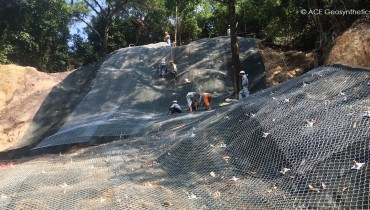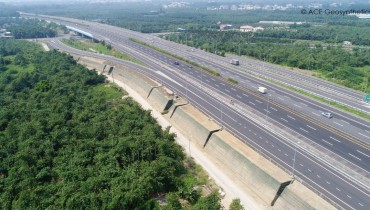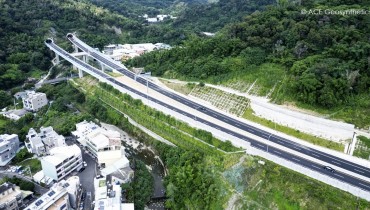News
Innovative Flood Management: Detention Pond with Flood Control and Recreational Design
Detention Pond with Reinforced Earth Dike for Fazi River, Taichung, Taiwan

Background
In recent years, due to global climate anomalies, there has been a noticeable increase in extreme hydrological events, with the affected areas and severity far surpassing those of the past. The Shisanliao drainage system is located in the hillside region of a district in Taichung City, connecting to a primary tributary of the Fazi River. Due to the insufficient capacity of the existing drainage system, relevant authorities have planned improvements to the drainage system and have set up a retention pond to reduce peak flows and prevent flooding.
Problem
Due to certain parts of the river channels around Shisanliao being encroached upon and having unclear flow paths, the capacity for flood discharge is noticeably insufficient. The existing drainage within the community, while able to handle the surface runoff from that specific area, cannot cope with the increased runoff from external regions. This leads to inadequate water discharge and a subsequent rise in upstream water levels, causing flooding in nearby areas. In order to effectively reduce or mitigate the flood-prone areas and improve agricultural yield and land utilization, it's essential to reduce peak flow rates, ensuring the safety and protection of residents' lives and property in the region.
Design& Construction

Considering all the issues that caused flooding, the authority decided to improve the discharge capacity of the drainage system by widening its drainage section. A flood detention pond with an area of approximately 2 hectares also was constructed alongside the drainage system to reduce peak flood flow. The site's original topography descends gently from northwest to southeast and thus causes a height difference of about 3.5m from the west to the east of the detention pond. The designer decided to build a reinforced earth dike, from west across to east, with its height gradually changing from 0.5m to 3.5m to accommodate the terrain and to maintain an equal elevation for the top of the detention pond.

A reinforced earth structure was selected because it can be built more efficiently using available site materials, presenting more convenience than reinforced concrete structures. The green system also supports an eco-friendly environment and creates an aesthetic landscape appearance. Because of the gravelly nature of the local geological material, retaining the surface runoff and keeping it as a wet pond is impractical. The flood detention pond was thus designed as a dry type with a permeable bottom to allow excess water to infiltrate and recharge groundwater. This approach simultaneously replenishes groundwater and promotes effective soil and water preservation. In this project, the bottom of the detention pond is divided into two terrain elevation zones. The sedimentation area is set at the lowest point, primarily serving daily drainage needs. The area with a higher elevation, when not used for water retention, acts as a convenient and safe recreational space for community residents. The two zones are separated by gabions. Through these strategic designs, the flood detention pond not only addresses drainage issues but also ensures community safety and environmental sustainability.

Results
This project applied a reinforced earth dike for the detention pond. It provides water conservation and facilitates regional drainage, thus significantly reducing the risk of flooding. It has efficiently alleviated the flooding potential for over 16 hectares around the detention pond. Furthermore, the constructed detention pond improves local crop production and land applications, avoiding regional residents' life hazards and ensuring their property safety.
The reinforced earth dike made of in-situ geological materials provides reliable structural stability and significantly reduces material transportation costs and time. Such a strategy aligns with the principles of engineering sustainability, promoting energy conservation and carbon reduction. In addition, the lush greenery covering the surface of the dike enhances the aesthetic appeal of the surroundings of the flood detention pond while promoting ecological sustainability.

Similar News

Safeguarding for Shallow Slope Sliding: A Sustainable Slope Stabilization Project
TOP STORY Shallow Landslide Treatment Project, Ba Deo Park, Ha Long City, Vietnam Backgr...

Reinforcement of the Slope at the Entrance Ramp of Interchange on National Freeway, Taiwan
"TOP STORY" In Taiwan, an island nation, freeways play a pivotal role in facilitating...

Geosynthetic Reinforced Soil Embankment for Earthquake Rehabilitation on National Freeway No. 4 in Taiwan
"TOP STORY" Located at the boundary of the Eurasian plate and the Philippine plate,...
